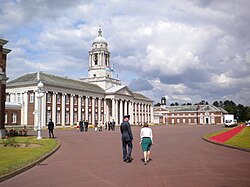| RAF Cranwell | |||||||||||||
|---|---|---|---|---|---|---|---|---|---|---|---|---|---|
| Near Cranwell, Lincolnshire in England | |||||||||||||
 College Hall at Royal Air Force College Cranwell | |||||||||||||
 | |||||||||||||
| Site information | |||||||||||||
| Type | Training station | ||||||||||||
| Owner | Ministry of Defence | ||||||||||||
| Operator | Royal Air Force | ||||||||||||
| Controlled by | No. 22 Group (Training) | ||||||||||||
| Condition | Operational | ||||||||||||
| Website | Official website | ||||||||||||
| Location | |||||||||||||
| Coordinates | 53°01′49″N000°29′00″W / 53.03028°N 0.48333°W | ||||||||||||
| Area | 700 hectares (1,700 acres) [2] | ||||||||||||
| Site history | |||||||||||||
| Built | 1916 | ||||||||||||
| In use | 1916–1918 (Royal Naval Air Service) 1918 – present (Royal Air Force) | ||||||||||||
| Garrison information | |||||||||||||
| Current commander | Wing Commander Matthew "Chocka" Thornton [3] | ||||||||||||
| Occupants |
| ||||||||||||
| Airfield information | |||||||||||||
| Identifiers | ICAO: EGYD, WMO: 03379 | ||||||||||||
| Elevation | 67.7 metres (222 ft) AMSL | ||||||||||||
| |||||||||||||
| Source: UK MIL AIP Cranwell [4] | |||||||||||||
Royal Air Force Cranwell or more simply RAF Cranwell( ICAO : EGYD) is a Royal Air Force station in Lincolnshire, England, close to the village of Cranwell, near Sleaford. Among other functions, it is home to the Royal Air Force College (RAFC), which trains the RAF's new officers and aircrew. The motto, Altium Altrix, meaning "Nurture the highest" appears above the main doors of the Officers Mess. [5] Since January 2025, RAF Cranwell has been commanded by Wing Commander Matthew "Chocka" Thornton. [6]



